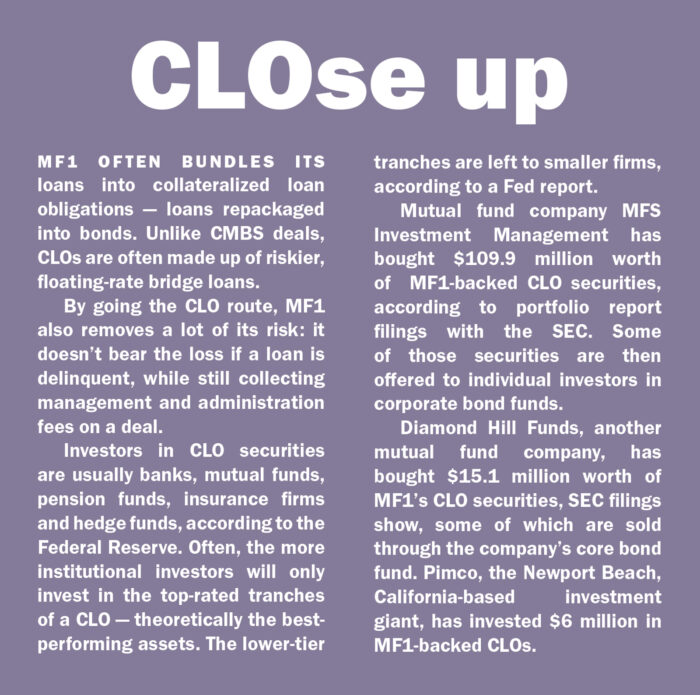When the Tides go out
MF1 aspired to be multifamily syndicators' favorite lender. It achieved that, but what was the cost?

Last summer, well before multifamily syndicator Tides Equities would show its troubled hand to investors, economists warned that the Federal Reserve’s rapid rate hikes could trigger a wave of defaults.
Meanwhile, MF1 Capital, one of Tides’ favored lenders, was doling out loans like it was 2021.
The debt fund, led by Scott Waynebern, originated at least $7.4 billion in debt between 2020 and 2021, giving high-leverage loans to multifamily syndicators looking to act on aggressive fix-and-flip plans.
Though the loans were floating-rate, they were short-term, the benchmark federal funds rate was near zero, and most real estate players did not expect inflation, then dubbed transitory, to set off the Fed’s aggressive rate hikes.
But industry observers say that by 2022, with the fight against inflation in the spotlight, a downturn was apparent to anyone willing to notice it.
“You could make an argument the writing was on the wall by the end of 2021, and especially the first quarter of 2022,” one Sun Belt-focused investor said.
Through summer 2022, however, MF1 kept issuing floating-rate loans on deals that hinged on the ability to substantially raise cash flows. Now, across MF1’s almost $11 billion amortizing loan book, almost half of the deals are either watchlisted or delinquent, according to The Real Deal’s analysis of Morningstar data. MF1 declined to comment.
The Tides problem is particularly acute: At least $425 million in MF1-issued loans in its portfolio have landed on servicer watchlists after rising rates hurt cash flow and made it tough for the firm to make interest payments on its debts.
The bulk of MF1’s issued loans come due in the next 18 months, at a time of rising defaults and a dearth of new financing. Lenders will be left to make tough choices — take back the keys or sell loans at a loss.
As more syndicators barrel toward distress, observers question how much of a role lenders such as MF1 played in their downfall.
Borrow cheap, lend cheap
MF1 Capital, like fellow debt funds LoanCore, Ready Capital and Arbor Realty Trust, substantially upped its game after the Fed’s 2020 rate cuts.
As banks pulled back on commercial real estate lending, private lenders saw an opening. Debt funds tapped warehouse lines — bank-financed credit — at ultra-low rates, lent that money at higher albeit still record-low rates and pocketed the difference.
They “seemed to be a low-interest-rate phenomenon where they could borrow cheaply and lend out,” said Alex DuFour, a real estate finance attorney at Cozen O’Connor.
And while banks offered more conservative products — deals with lower loan-to-value ratios that demanded a larger equity commitment — debt funds cornered the market for high-leverage, value-add deals.
MF1, a joint venture between Limekiln Real Estate and Berkshire Residential Investments, emerged in 2019. Its name touted its niche and ambition: MF for multifamily, 1 for industry leader.
“Somehow all roads lead to us, and [we] quickly created the No. 1 brand in the market.”
“Somehow all roads lead to us and what we were doing last year, and [we] quickly created the No. 1 brand in the market,” MF1’s Waynebern, who spent 14 years at Deutsche Bank before Limekiln, said in 2022. “We tripled our business.”
MF1 had two calling cards: Its floating-rate loans were cheaper, and the short-term maturities provided flexibility. Borrowers could sell properties without being tied to longer loans and could close deals quickly.
“They’re really risky deals — if you’re going to borrow high-leverage, floating-rate debt, you should only do it on a deal you have true conviction in,” said a source familiar with Tides’ financing. “But guys who are less institutional are going to say, ‘This is great.’”
Don’t hate the player
If owners could raise rents by renovating a tired apartment complex, they could boost income and improve debt-service coverage ratios. Eventually, that would reflect in property value, which would lower their leverage by the time the loan was due.
The big if there, however, was that rates would stay low while rents could keep rising.
In 2022 alone, MF1 securitized three loan pools totaling $4.7 billion, according to reports from ratings agencies. By comparison, in 2021, it securitized three loan pools totaling $3.4 billion.
“If people are paying a certain price for properties, you have two choices,” said Manus Clancy, who leads CMBS research at Trepp. “You either join the herd or you sit it out.”
“Most people say, ‘Well, this is where the market is, and I want to keep playing the game,’” he added.
In August 2022, the same month Fed Chair Jerome Powell acknowledged that higher rates would “bring some pain to households and businesses,” MF1 loaned Tides $55 million for a Phoenix-area acquisition.
The floating-rate loan on the property, Tides on Country Club, was made at 79 percent loan-to-value and a debt-service coverage ratio of 0.8, meaning that cash flow could not cover debt payments.
Tides planned to boost cash flow by 61 percent in two years. Meanwhile, rent growth was slowing nationally. In Phoenix, rents rose just 2.1 percent annually in August after double-digit gains the year prior, according to Realtor.com. By October, rents had started slipping.
Lenders were also underwriting deals that assumed rent growth would keep pace with 2021 gains and exit cap rates would stay low, despite signs to the contrary.
In June 2022, Tides bought a 270-unit complex in Fort Worth, Texas — dubbed Tides on Oakland Hills — for $33 million, according to investor documents obtained by TRD.
The market was already changing, but MF1’s loan terms weren’t: It gave Tides a $26.2 million two-year, floating-rate loan for the purchase. Tides projected an exit cap of 5.1 percent, assuming a sale in 2024.
Cap rates typically move with the 10-year Treasury rate, topping it by an average of 3 percentage points. In May 2022, before Tides closed on the deal, the Congressional Budget Office forecast that the 10-year Treasury would hit 3.1 percent by the end of 2024.
Taking the average spread into account, that increase would push the prevailing cap rate over 6 percent — above MF1’s underwriting. At that cap rate, assuming Tides managed to hit its projected net operating income of $2 million, the firm would exit the property for the same price it originally paid.
MF1’s loan on Tides on Oakland Hills is currently on a servicer watchlist, with Tides not pulling in enough income to service its debt.
“Most people say, ‘Well, this is where the market is, and I want to keep playing the game.’”
One industry observer characterized late-cycle underwriting that assumed a “best-case scenario” as “irresponsible” — particularly if the lender was making high-leverage loans.
Tides has scored more than 30 deals from MF1, according to Morningstar. But MF1 has also been busy bankrolling other syndicators now facing distress, including Rise48 and ZMR Capital, as well as seasoned investors such as A&E Real Estate, all of which have loans on watchlists.
Yat-Pang Au’s San Francisco-based Veritas Investments, another frequent borrower from MF1, tapped the firm for $924 million in loans between 2020 and 2021 to finance multifamily acquisitions in San Francisco and Los Angeles. Almost a quarter of that debt has been watchlisted for distress.
Parachutes
The focus for many borrowers and lenders is now on exit strategies.
Most bridge loans carry extension options. But if a borrower opts to extend, lenders will require it to purchase a new rate cap, an insurance policy that insulates sponsors when rates rise above a certain threshold.
A rate cap’s price is tied to the benchmark federal funds rate. Sponsors that nabbed loans in 2021 through early 2022 paid just 0.25 percent of their total debt. The going rate has since surged to 5 to 5.25 percent.
“You can’t fund this out of cash flow, because higher interest rates have squeezed away all your cash flow,” Trepp’s Clancy said. “So this amounts to a capital call.”
With multifamily valuations down by a fifth, distressed investors will be forced to evaluate whether the property is worth another cash infusion. But if more equity can get a renovation completed and boost revenue enough to service debt, it may be worth it.
“If a borrower is doing a reasonable job operating, and is willing to put more equity in a deal, there’s going to be a lot of flexibility,” one debt fund operator said.
For those unwilling or unable to cough up more equity, lenders have three remedies: Extend and pretend, take back the asset or sell the mortgage to a third party willing to do the dirty work of foreclosure.
“A lot of lenders are holding out as long as they can, because there’s no upside to selling at a loss now,” said Jay Parsons, an economist at RealPage.
Some debt funds are hoping they won’t be saddled with properties they aren’t set up to manage. Others, though, might be open to the headache if they see enough profit in a subsequent sale.
On at least one property, MF1 has been willing to take that risk.
In March, it filed to foreclose on a 128-unit apartment complex in Fort Lee, New Jersey, after the owners fell behind on payments, court records show.
New-to-the-game investors Joseph Rubin and Sam Haikins of Blue Diamond Equities bought the building, dubbed the Sterling, in May 2022 with a $46 million loan at 80 percent leverage, then fell delinquent eight months later.
In April, MF1 helped push through a sale of a Downtown L.A. apartment portfolio with more than 1,000 units to Miami-based Fifteen Group. MF1 had loaned $329 million to the sponsor, Laguna Point Properties, just a year earlier, but the deal flamed out spectacularly.
Debt funds unwilling to foreclose may opt to sell notes. It’s a scenario in which they will likely lose some money, but given that multifamily, unlike office, still has strong demand, it won’t be a body blow.
Bankruptcy is another path for syndicators in a cash crunch, industry insiders say. But most of the bridge loans coming due carry a so-called “bad boy” guarantee — a declaration that the borrower won’t commit a nefarious act, like filing for bankruptcy or scoring subordinate debt on a property without a lender’s consent.
If any do file for bankruptcy, it would break the guarantee and lenders could go after more than just the property.
A person familiar with multifamily syndicators put it thus: “It’s [like] when you mortgage all your properties in Monopoly — you’re done.”
Awards season
However the distress story plays out, it will leave lasting scars on all sides of the multifamily market.
A rash of foreclosures will reset multifamily valuations, deterring sales by owners who bought at market highs.
Syndicators who default will likely lose credibility among investors and may struggle to score future lending.
“The market punishes them by reputation,” the Sun Belt multifamily investor said.
Lenders, including MF1, are likely well-capitalized enough to ride out the storm. But their reputations — and egos — will take a solid hit.
“People always ask what does the ʻ1’ stand for?” Waynebern posted recently after MF1 bagged an industry award. “Another recognition that MF1 is #1.”
The award was for MF1’s eighth debt securitization, which extended $2 billion in loans to 31 sponsors to finance 38 multifamily buys.
A TRD analysis of the deal shows that $746 million of those loans are watchlisted or already delinquent.





